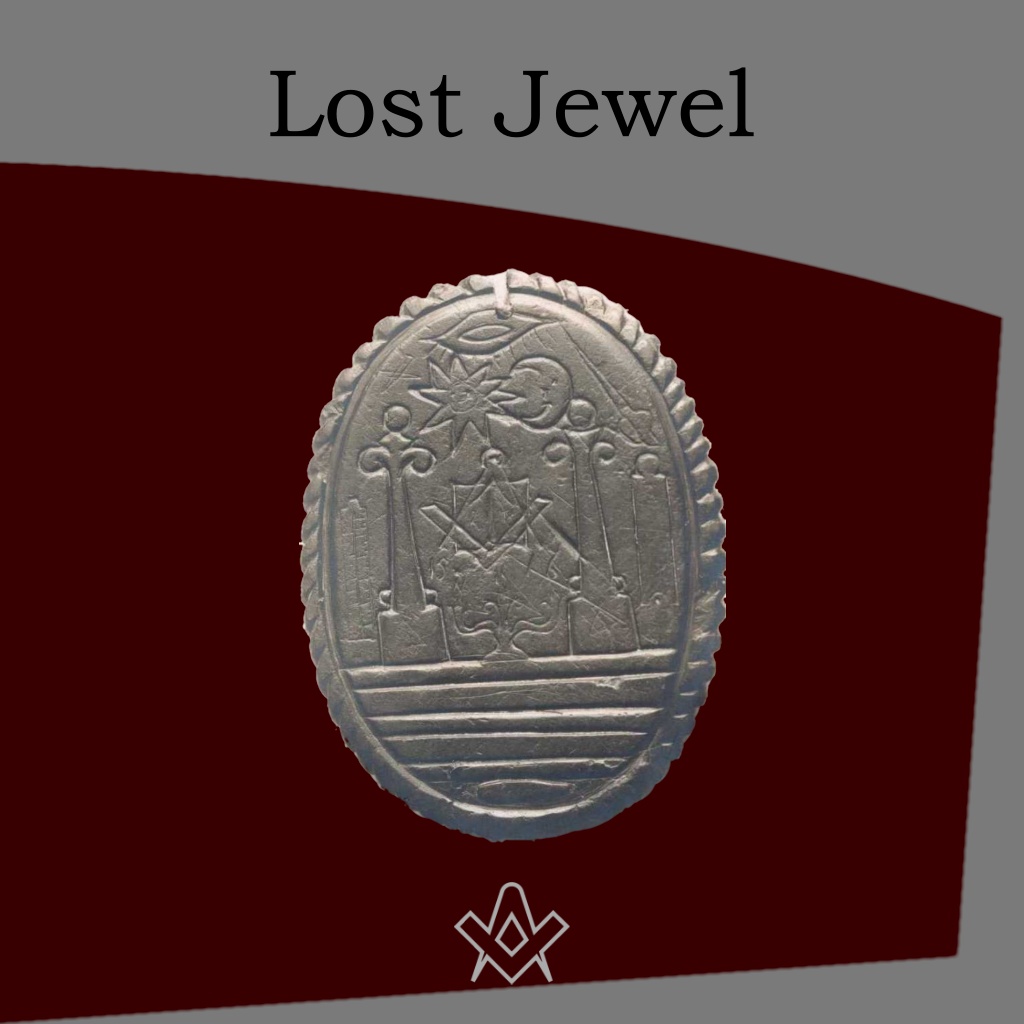Like many Masonic researchers I can often be found rummaging through second-hand book shops looking for any works of Masonic interest.
One such fine bookshop is Barter Books in Alnwick, where I managed to acquire a dozen or so old books in one afternoon of haggling.
When I arrived home and flicked through the books, I was surprised to find three old photographs. The first of which can be seen below.

Sarah Dowd at her house in Dromore, Ireland.
IMAGE CREDIT: Author’s own collection
The writing at the bottom explains that the ladies name is Sarah Dowd, who found a Masonic jewel at this house in 1912.
The house, it explains is at Dromore and the jewel is inscribed with the date 1516. What exciting serendipity.
The second photograph, below, is one face of the Masonic jewel which Sarah found. As you can see it is covered with Craft symbolism.
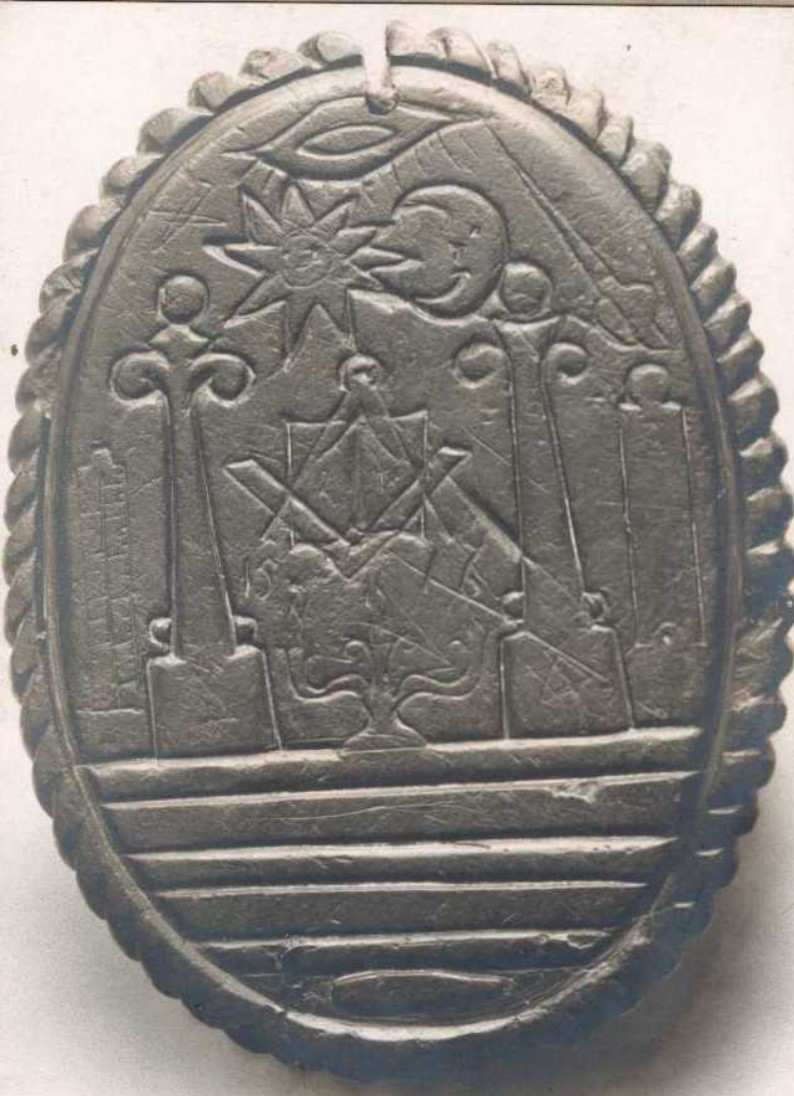
Jewel front – with Craft symbolism
IMAGE CREDIT: Author’s own collection
You can see two pillars, celestial/terrestrial… three great lights…sun/moon…three lesser lights…seven steps, and interestingly a coffin.
Some insist that the Third Degree is a modern contrivance, but this would indicate otherwise.
There is, however, a correction to the original date on the jewel of 1516.
As you can see the error is due to the fact that the third flame of the lesser light has been mistaken for the circular base of the number ‘6’.
The actual date is 1517. Not that 12 months is of great importance with an item nearly 500 years’ old.
Those of you in the know understand the importance of this. A Masonic jewel existing 200 years before Grand Lodge! Not possible.
How can Freemasonry exist without Grand Lodges collecting money for charity and doing clerical work?
Well as you will see in the next image it operated very nicely thanks very much.
This is the reverse image of the jewel. As you can see it is covered with Royal Arch symbolism.
This again will require a rewrite of the history books. Royal Arch has its earliest reference as Yaughal, County Cork 1743.
This evidence is hundreds of years earlier. Showing that it was well established with all of its esoteric symbolism.

Jewel reverse with Royal Arch symbolism
IMAGE CREDIT: Author’s own collection
As an interesting aside associated with the period of time between the Kirkwall Scroll (1480) and the jewel (1517), I would like to include a comment by Dr Robert Lomas.
Bro. Robert explained that he had recently came across minutes of a lodge in Aberdeen dated 1490, which stated that the W.M. Alexander Stewart had been appointed as Alderman for the City of Aberdeen.
The minutes note that he was appointed to the esteemed post of alderman because he was the W.M. and that he was the W.M. because he was an esteemed city alderman.
Each position complemented the other. This fact should cast doubt on the romantic speculation that our Craft originated with bands of itinerant brick layers.
I took the notion to find out more and went to Dromore in County Tyrone.
I enquired in the post office if any Dowds still lived in the town and was given directions to a terraced house.
At the house I met an elderly lady who confirmed that the Sarah Dowd in the photo was in fact her mother-in-law, but she had no idea of the location of the house where the 1517 jewel was found.
I thanked her for her time and took a drive around Dromore to get a feel for where the world’s oldest Masonic jewel was discovered.
I parked at the top of a brow so as to look back on the town and noticed this pile of stones on the other side of the hedgerow.
After clambering through brambles, I spotted a small section of dry-stone wall.
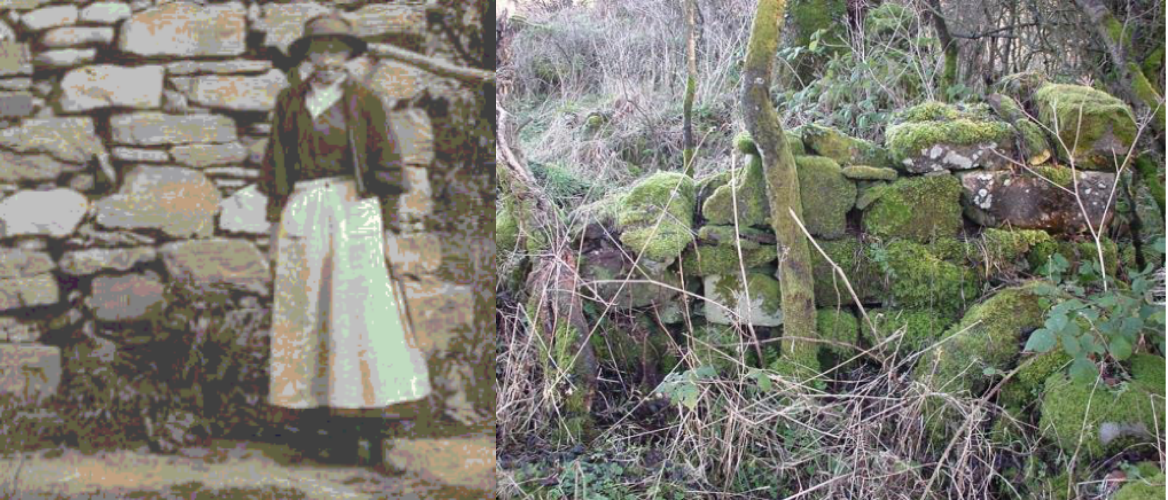
LEFT: Sarah Dowd and detail of the stone wall in Dromore, where she found the jewel
RIGHT: Stone wall in Dromore, as discovered by the author
IMAGE CREDIT: Author’s own collection
As you can see the irregular shape of one particular stone matches that in the 1912 photo of Sarah Dowd.
Looking closer you will notice that that the other stones match those in the photo.
So, the beautiful hand of serendipity had led me to the exact spot at which nearly 100 years earlier Sarah Dowd had discovered the world’s oldest Masonic jewel.

silicone moulds taken from the original 1517 clay jewel
IMAGE CREDIT: Author’s own collection
But the story does not end there…
Sometime after discovering Sarah Dowd’s house, I visited a Masonic lodge in Ireland.
I was examining a cabinet filled with Masonic jewels when I spotted something at the back.
I called over another Brother who was familiar with the story of the jewel.
I pointed at a dark object at the back of the cabinet and asked ‘is that what I think it is?’ He then confirmed it was the original 1517 clay jewel.
Through various means, I obtained the keys to cabinet and returned with a silicone moulding kit, with which I made copies of the jewel. I then, of course, returned it to its rightful place.
Article by: Martin Jackson
Martin is a Freemason of 20 years, initiated into Scott M.L. 300 Coalisland, Northern Ireland.
He is also a member of Mark, Royal Arch and Knight of the East and West.
He is the designer, along with his brother Trevor, of the covers of several books by Masonic author Robert Lomas.
They also created a set of eight contemporary tracing boards.
Recent Articles: masonic history
 Protestantism and Masonic Influence in Brazil Discover the untold story of how Freemasons helped Southern Americans immigrate to Brazil post-Civil War, fostering economic and educational growth in Santa Bárbara d’Oeste and Americana. Learn about their pivotal role in establishing Protestant churches and ensuring the secularity of the Brazilian State amidst a Catholic-dominated society. |
 Explore the proper use of the sacred word in Brazilian Freemasonry through an analysis of Masonic literature and Bible translations. Uncover the errors in pronunciation and the need for corrections to maintain liturgical coherence in rituals. Discover insights on Masonry, rituals, and the Hebrew word Boaz. |
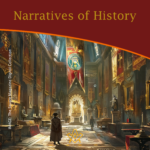 Narratives of History |
 A Very Royal Sesquicentenary |
 Unveiling the Enigma: Discover the Royal Society's Legacy and its Impact on Science. Delve into the fascinating history of the Royal Society, the prestigious UK academy shaping scientific progress since 1660. Explore its pivotal role in advancing knowledge, fostering collaboration, and unlocking the secrets of the universe. Prepare to be amazed! |
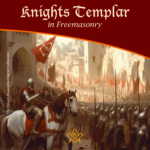 Knights Templar in Freemasonry Uncover the Mysteries of the Knights Templar in Freemasonry! Delve into the intriguing world where chivalry and symbolism intertwine. Discover the captivating rituals and ancient secrets behind the Knights Templar Masonic Orders. Explore the historical connection and delve into the enigmatic narratives that continue to fascinate enthusiasts today. Unveil the hidden truths now! |
 The Royal Arch stands as the rainbow of promise in the Ritual; it stands as the promise of the resurrection; of that which was lost and that it shall be recovered. The question arises as to whether the Master's Word was originally communicated in the Third Degree? On this point there is some diversity of opinion. Originally published in 1915, this insight into the Fourth Degree – the Holy Royal Arch – is as relevant today as it was over 100 years ago. |
 Unveiling the Mysteries of Druidism: Discover the Intriguing Connection with Freemasonry. Explore the ancient spiritual practice of Druidism and its fascinating ties to the enigmatic world of Freemasonry. Delve into the shared symbolism and rituals that have captivated minds for centuries. Unlock the secrets of these intertwined traditions today! |
 Uncover the legacy of freestone masons and their pivotal role in crafting medieval cathedrals. Discover the artistry behind their techniques, the hierarchy within their craft, and the enduring impact of their intricate carvings. A deep dive into the world of these master craftsmen awaits you! |
 Unearth the intriguing journey from Vincha Culture to Freemasonry. Discover how ancient building methods intertwine with modern Masonic philosophies. This exploration will shed light on the fascinating link between the Serbian term "shestarenye" and the symbolic significance of the compass in Freemasonry. |
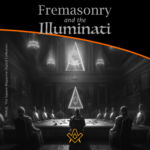 Freemasonry and the Illuminati Unravel the enigmatic world of Freemasonry and the Illuminati in our latest exposé. Dive into centuries-old mysteries, debunk conspiracy theories, and discover the truth behind these elusive societies. Are they puppet masters or mere myths? Join us as we dissect history and fact from fiction. |
 The Île des Templiers, or “Island of the Templars” lies within a leafy park in Paris. The execution site of Jacques du Molay, the last Grand Master of the Knights’ Templar bears a plaque with the epitaph ‘A cet endroit / Jacques de Molay / Dernier grand maître / de l'ordre du temple / a été brûlé le 18 Mars 1314’ (‘In this location / Jacques de Molay / Last grand master / of the order of the temple / was burned on 18 March 1314’) |
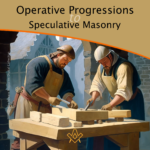 Operative Progressions to Speculative Masonry Both Operative and Speculative Masonry are an important part of the modern fraternity of Freemasonry, which combines elements of both traditions. Today, Freemasonry is a fraternity that is open to men of good character, who are interested in personal development and in making a positive contribution to their communities. |
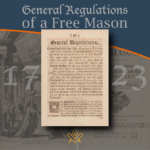 General Regulations of a Free Mason, 1723 General Regulations of a Free Mason as contained in Anderson's Constitutions of the Freemasons, published 1723. the Regulations are of great historical interest. Compiled by George Payne, the second Grand Master of the Premier Grand Lodge of England, they were printed in 1722/3, thus published just over five years after the formation of the Grand Lodge 1717. |
 The Genesis of the 1723 Book of Constitutions 2023, marks the three hundredth anniversary of the publication of the first printed Book of Constitutions of the Grand Lodge formally established in London two years previously. This is an anniversary whose significance extends beyond freemasonry. A paper by Andrew Prescott |
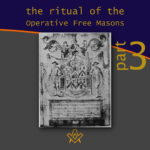 The Ritual of the Operative Free Masons - P3 Existing Operative Free Masons. The ritual I am about to refer, is that of "The Worshipful Society of Free Masons, Rough Masons, Wallers, Slaters, Paviors, Plaisterers, and Bricklayers." By Thomas Carr, M.D., P. M. Honorary Member of the Guild of Operative Free Masons |
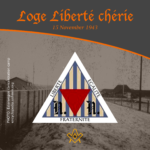 Liberté chérie was a Masonic Lodge founded in 1943 by Belgian Resistance fighters and other political prisoners at Esterwegen concentration camp. It was one of the few lodges of Freemasons founded within a Nazi concentration camp during the Second World War. |
 The Ritual of the Operative Free Masons - P2 If anyone doubts the fact that the formation of Speculative Free Masonry was due to and based upon Operative Free Masonry, it is quite easy to convince him of his error if he will only study the first Book of Constitutions. By Thomas Carr, M.D., P. M. Honorary Member of the Guild of Operative Free Masons |
 In 1881, Freemasonry rose from the ashes of a fire in the mining town of Kokomo, Summit County, Colorado. Corinthian Lodge No. 42, along with Kokomo, no longer exists but it holds the record of having been – at an elevation of 10,618 feet – the highest Masonic Lodge in the USA. |
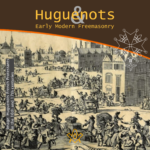 The Huguenots and Early Modern Freemasonry The Huguenots influence in the development of early modern Freemasonry at the time of the formation of the Grand Lodge in London around 1717 / 1723. |
 November is a month of reflection – perhaps due to the fact that we are getting close to the years' end – but also because Remembrance / Armistice Day (11 November) is a significant date in most countries' diaries. |
 Speculative Freemasonry, as practise by Grand Lodge of England, was officially born just over three hundred years ago, is today an international organisation, counting over six million members. It has been subjected to persecution, suppression, and abolition throughout its history. In its infancy, only a couple of decades after its official birth, it had already become a target. |
 The Ritual of the Operative Free Masons - P1 The original paper was written, first, to prove that Speculative Free Masonry was derived from Operative Free Masonry; second, to give some account of the Operative Free Masons, of their Ritual, and of their customs. By Thomas Carr, M.D., P. M. Honorary Member of the Guild of Operative Free Masons |
 American Fraternalism in the 19th and Early 20th Centuries The late 19th and early 20th centuries in the United States has been called the "Golden Age of Fraternalism." How did this come about and why was the idea of joining a fraternal organization so popular? We will explore this question and examine the regalia used by many fraternal organizations in this period. |
 Societas Draconistarum, meaning "Society of the Dragonists"– was a chivalric Order for selected nobility, founded in 1408 by Sigismund von Luxembourg, who through marriage became the King of Hungary (1387–1437) and later Holy Roman Emperor. The Order was fashioned after the military orders of the Crusades, requiring its initiates to defend the cross and fight the enemies of Christianity, in particular the Ottoman Empire. |
 The Perjured Free Mason Detected Was Samuel Prichard a perjured individual, or simply a misguided Freemason? Prichard's book "Free Masonry Dissected" published in 1730, is now used by many Masonic historians as a source of reference with regards to the introduction of the third degree into the Craft. But at the time it was published in 1730, it was not so well received by members of the Grand Lodge of England. |
 17th century and the Holy Royal Arch This article focuses on a period of transition between a point in time when we can safely and historically identify the first formation of what could be called as the ‘Royal Arch’ and the historical events that have preceded it. |
 Most Freemasons have heard the terms 'Operative' and 'Speculative' Masons, and this article helps to understand the difference: |
 Roberts' Constitutions of Freemasonry 1722 Published a year before Anderson's Constitutions, The Old Constitutions Belonging to the Ancient and Honourable SOCIETY OF Free and Accepted MASONS. Originally printed in London England; Sold by J. Roberts, in Warwick-Lane, MDCCXXII.(1722) |
 From 'Songs of religion and life', 1876 by John Stuart Blackie (1809-1895) |
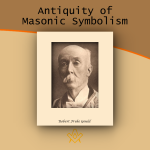 On the Antiquity of Masonic Symbolism Is the Symbolism of Masonry an inheritance derived from the old Masons who flourished before the era of the Grand Lodges (1717); or has it been borrowed from the Rosicrucians or others, after 1717? |
 Mason's Marks – from Egypt to Europe? Mason's marks have been a source of intrigue, not only to Freemasons but to historians and archaeologists. The use of simple pictograms have been employed for millennia by artisans to identify their work. But where did they originate and why? |
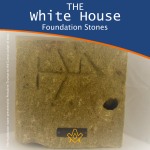 The White House Foundation Stones Further to the articles in our series on the history of the stone masons, we have a rather intriguing addition. During the 1950's renovation of the White House, President Truman retrieved more than 100 stone blocks with stonemasons marks. |
 What the Goose and Gridiron Tavern is in the ancient annals of London Freemasonry, The Green Dragon Tavern is to the memories of the Free-mason, of Boston and New England. |
 Auschwitz concentration camp: video photo article taken in 2013 |
 There are two things of importance happening this day - 27 January |
 Two approaches regarding the understanding of Freemasonry |
 Masonic Research in England c1930 An article which appeared in an American Masonic magazine, c1930 and which was reproduced in England, provoking a little controversy. |
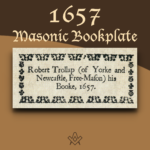 Masonic bookplates the ‘Brethren’s spiritual coats of arms and marks’ |
 The Unlawful Societies Act of 1799 Rebellious Freemasons and the 21st century |
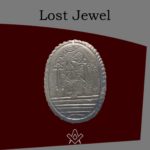 In 1912, Sarah Dowd of Dromore, Ireland, found a Masonic jewel dated 1517 - a date two hundred years before the establishment of Grand Lodge... |
 Freemasonry and Fascist Regime Interesting speech by the famous historian Prof. Aldo A. Mola, who links the fascist regime with the Masonic Associations. |
 Was famous Russian poet Alexander Pushkin a Freemason? And if so, was he a member of the lodge ‘for which all the lodges in Russia were destroyed’? |
 The Importance of Masonic Research Why is accurate - or authentic - Masonic research so important? The importance of making a daily advancement in Masonic knowledge is something that The Square is passionate about promoting. |
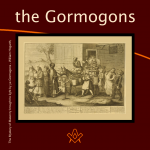 The Antient Noble Order of the Gormogons had a brief existence in the eighteenth century; they left few records or accomplishments, |
masonic knowledge
to be a better citizen of the world
share the square with two brothers

click image to open email app on mobile device


